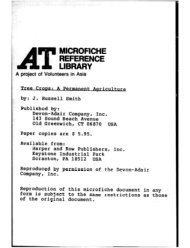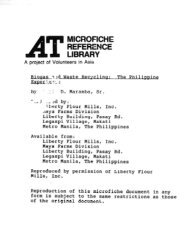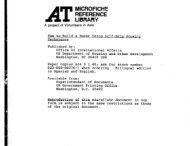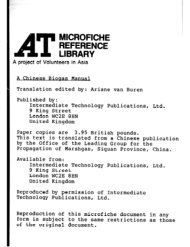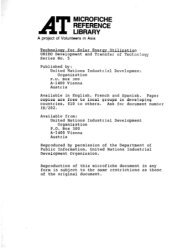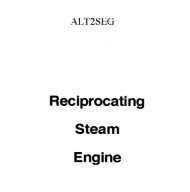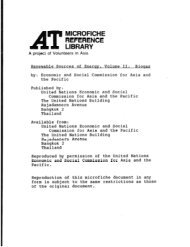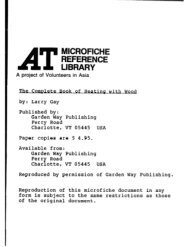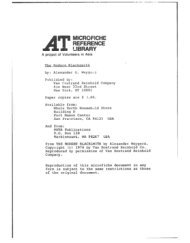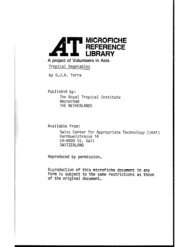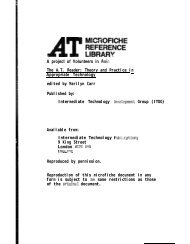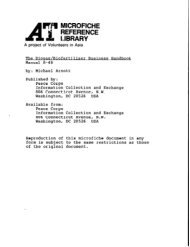Vegetation as an indicator of high wind velocity
Vegetation as an indicator of high wind velocity
Vegetation as an indicator of high wind velocity
Create successful ePaper yourself
Turn your PDF publications into a flip-book with our unique Google optimized e-Paper software.
E = w -P J<br />
‘: A<br />
Shape Index (S) A me<strong>as</strong>ure <strong>of</strong> the relative influtLnce <strong>of</strong> <strong>wind</strong> on&dial "<br />
<strong>an</strong>d apical trunk growth. The ratio is calculated by dividing the&r-<br />
cumference <strong>of</strong> the tree at 1.5 m by its height (See Figs. 4,5;6, <strong>an</strong>d.7). :<br />
Griggs-Putnum Type Deformation Rating (G) A subjective 'rating scale<br />
similar to that developed by Putnam (1948). Each tree is given a rating<br />
b<strong>as</strong>ed on the characteristics <strong>of</strong> its <strong>wind</strong> deformation (see Fig. 8).<br />
Deformation Ratio (D) An ind'-cator <strong>of</strong> the degree <strong>of</strong> <strong>wind</strong> induced<br />
flagging <strong>of</strong> a tree. A ratio <strong>of</strong> <strong>an</strong>gle a (the <strong>an</strong>gle between the crown <strong>an</strong>d<br />
the trunk on the leeward side <strong>of</strong> the tree) <strong>an</strong>d <strong>an</strong>gle 8 (the <strong>an</strong>gle between<br />
the crown <strong>an</strong>d the t?unk <strong>of</strong> the <strong>wind</strong>ward side <strong>of</strong> the tree) is calculated<br />
<strong>as</strong> in Fig. 9.<br />
Compression Ratio (C) An <strong>indicator</strong> <strong>of</strong> the influence <strong>of</strong> the <strong>wind</strong> on the<br />
formation <strong>of</strong> reaction wood. The ratio is calculated by taking the <strong>an</strong>nual<br />
increment <strong>of</strong> growth <strong>of</strong> the bole or trunk on the leeward side <strong>of</strong> the tree<br />
<strong>an</strong>d dividing it by increment <strong>of</strong> growth <strong>of</strong> the bole on the <strong>wind</strong>ward side<br />
<strong>of</strong> the tree (Fig. 10).<br />
ii. Background for Development <strong>of</strong> these Indices<br />
Eccentricity is a ratio which defines the degree <strong>of</strong> departure<br />
from circularity. The eccentric growth <strong>of</strong> tree rings, with wider rings<br />
on the lee side <strong>of</strong> the tree, h<strong>as</strong> <strong>of</strong>ten been observed in nature. B<strong>an</strong>n<strong>an</strong><br />
<strong>an</strong>d Rindra (1970) found <strong>an</strong> eccentricity in the cross section <strong>of</strong> trunks<br />
<strong>of</strong> several coniferous species which could not 'be <strong>as</strong>cribed to differential<br />
insolation. They found the major axis to be in the direction parallel<br />
to the prevailing <strong>wind</strong>s. Similarly in Europe, Barsch (1963) found <strong>an</strong><br />
average ratio <strong>of</strong> 1.17 for the diameter in the direction <strong>of</strong> the prevailing<br />
<strong>wind</strong>s to that in the perpendicular direction. Jacobs (1954) firmly guyed<br />
tall pines <strong>an</strong>d found the ring increment to be uniform along the boles<br />
while unguyed trees developed eccentric growth. These results provided<br />
the framework for the index <strong>of</strong> eccentricity.<br />
Thinning to reduce stem density h<strong>as</strong> become a common forestry<br />
practice <strong>an</strong>d <strong>as</strong> a result, more attention is being focused on stem form<br />
development in thinned <strong>an</strong>d unthinned st<strong>an</strong>ds (Yerkes, 1960; Lohrey, 1961,<br />
Grom<strong>an</strong> <strong>an</strong>d Berg, 1971). Yerkes found that thinned Dougl<strong>as</strong>-fir had<br />
greater diameters th<strong>an</strong> the unthinned controls. According to Carlton (1976),<br />
<strong>wind</strong> sway w<strong>as</strong> probably responsible for incre<strong>as</strong>ed diameter growth along<br />
with incre<strong>as</strong>ed insolation, improved soil moisture <strong>an</strong>d improved rooting.<br />
-2-



